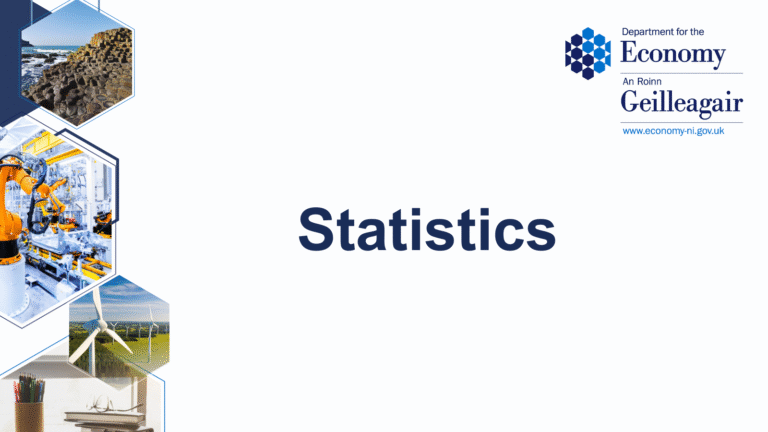Date published:
The labour market statistics were published today by the Northern Ireland Statistics & Research Agency.
Payrolled employees and median earnings increased over the year
- The number of employees receiving pay through HMRC PAYE in NI in August 2025 was 810,100, a decrease of 0.1% over the month and an increase 0.4% over the year.
- Earnings data from HMRC PAYE indicated that NI employees had a median monthly pay of £2,371 in August 2025, unchanged over the month and an increase of £67 (2.9%) over the year.
- The estimates from HMRC PAYE for the latest period are based on early data and, therefore, are more likely to be subject to larger revisions.
Labour Force Survey headline measures
- The latest NI seasonally adjusted unemployment rate (the proportion of economically active people aged 16 and over who were unemployed) for the period May-July 2025 was estimated from the Labour Force Survey at 2.2%. This represents an increase of 0.4 percentage points (pps) over the quarter and an increase of 0.4pps over the year.
- The proportion of people aged 16 to 64 in work (the employment rate) increased by 0.1pps over the quarter and decreased by 0.9pps over the year to 71.8%.
- The total number of weekly hours worked in NI was estimated at 29.3 million hours, a decrease of 3.4% on the previous quarter and unchanged from the equivalent period last year.
- The economic inactivity rate (the proportion of people aged 16 to 64 who were not working and not seeking or available to work) decreased by 0.4pps over the quarter and increased by 0.6pps over the year to 26.5%.
Seasonally adjusted claimant count rate unchanged over the month
- In August 2025, the seasonally adjusted number of people on the claimant count was 36,200 (3.7% of the workforce), which was unchanged from the previous month’s revised figure. The August 2025 claimant count is 21.3% higher than the pre-pandemic count in March 2020.
Latest annual total of confirmed redundancies lower than previous year
- NISRA, acting on behalf of the Department for the Economy, received confirmation that 170 redundancies occurred in August 2025. Over the year, September 2024 to August 2025, 2,430 redundancies were confirmed, which was approximately ninety-five percent of the figure for the previous year (2,550).
- There were 130 proposed redundancies in August 2025, taking the annual total to 3,080, which was over ten percent higher than the figure for the previous year (2,760).
Quarterly Employment Survey (QES) headline measures
- Businesses reported that employee jobs increased over the quarter (0.4%) and increased over the year (2.5%) to 842,740 jobs in June 2025.
Commentary
- The latest Labour Market results highlight a slowing down of the labour market within Northern Ireland. Across all sources changes in the employment levels over the year have been relatively small, with an increase in payrolled employee numbers from the HMRC payroll data and a decrease in the employment rate from the Labour Force Survey (LFS). Both the unemployment rate and the economic inactivity rate from the Labour Force Survey (LFS) have increased.
- The latest HMRC payroll data shows that payrolled employees decreased by 0.1% over the month and increased by 0.4% over the year. Payrolled earnings were unchanged over the month and were 2.9% higher than August 2024.
- Households reported, via the Labour Force Survey (LFS), over the year to May-July 2025, increases in both the unemployment rate (by 0.4pps to 2.2%) and the economic inactivity rate (by 0.6pps to 26.5%), while the employment rate decreased by 0.9pps to 71.8%. None of these annual changes were statistically significant.
- The total number of hours worked in May-July 2025 was unchanged over the year, at 29.3million hours per week. This figure is 0.7% above the pre-pandemic position recorded in November-January 2020 and is 3.4% below the highest level recorded in this time series (30.4 million hours per week, in February-April 2025).
- Businesses reported, via the Quarterly Employment Survey, that employee jobs in NI increased over the quarter and the year to reach a new series high, 842,740 jobs, in June 2025. Quarterly increases in employee jobs were seen within the manufacturing, other industry and services sectors while there was a quarterly decrease in the construction sector. The manufacturing and services sectors reached a new series high in June 2025. There were increases in employee jobs over the year within the manufacturing, construction and services sectors with an annual decrease in the other industries sector.
- In August 2025, the Department was notified of 170 confirmed redundancies, bringing the rolling twelve-month total of confirmed redundancies to 2,430, approximately ninety-five percent of the figure for the previous year (2,550). In addition, 130 proposed redundancies were notified to the Department in August 2025. The annual total of proposed redundancies was 3,080, over ten percent higher than the figure for the previous year (2,760). Both the twelve-month totals of proposed and confirmed redundancies are similar to the levels seen in the decade preceding the pandemic.
- Finally, the claimant count estimate over the month to August 2025 was unchanged from the revised figure for July 2025. The claimant count rate for August 2025 was also unchanged from the revised rate for July 2025 of 3.7%.
Notes to editors:
- The statistical report and associated tables are available on the NISRA website.
- The Northern Ireland Statistics and Research Agency wishes to thank the participating households and businesses for their co-operation in agreeing to take part in the surveys and for facilitating the collection of the relevant data.
- ‘Over the quarter’ refer to comparisons between the latest quarterly estimates for the period May-July 2025 and the quarter preceding that (i.e. February-April 2025). ‘Over the year’ refer to comparisons between the latest quarterly estimates for the period May-July 2025 and those of the corresponding quarter one year previously (i.e. May-July 2024). Changes that are significant in a statistical sense (i.e. where the estimated change exceeded the variability expected from a sample survey of this size and was likely to reflect real change) are specifically highlighted.
- Estimates relating to May-July 2025 should be compared with the estimates for February-April 2025. This provides a more robust estimate than comparing with the estimates for April-June 2025, as the May and June data are included within both estimates.
- The official measure of unemployment is from the Labour Force Survey. This measure of unemployment relates to people without a job who were available for work and had either looked for work in the last four weeks or were waiting to start a job. This is the International Labour Organisation definition. Labour Force Survey estimates are subject to sampling error. This means that the exact figure is likely to be contained in a range surrounding the estimate quoted. For example, the unemployment rate is likely to fall within 0.7pps of the quoted estimate (i.e. between 1.5% and 2.9%).
- The claimant count is an administrative data source derived from Jobs and Benefits Offices systems, which records the number of people claiming unemployment-related benefits. In March 2018, the NI claimant count measure changed from one based solely on Jobseekers Allowance (JSA) to an experimental measure based on JSA claimants and out-of-work Universal Credit (UC) claimants who were claiming principally for the reason of being unemployed. Those claiming unemployment-related benefits (either UC or JSA) may be wholly unemployed and seeking work or may be employed but with low income and/or low hours, that make them eligible for unemployment-related benefit support. Under UC a broader span of claimants became eligible for unemployment-related benefit than under the previous benefit regime.
- Redundancies are provided by companies under the Employment Rights (Northern Ireland) Order 1996 (Amended 8 October 2006) whereby they are legally required to notify the Department of impending redundancies of 20 or more employees. Companies who propose fewer than 20 redundancies are not required to notify the Department, therefore the figures provided are likely to be an underestimate of total job losses, however, it is not possible to quantify the extent of the shortfall. All other things being equal we would expect more redundancies in sectors dominated by large businesses as they are the businesses that meet the 20 or more collective redundancy criteria.
- To prevent the potential identification of individual businesses, redundancy totals relating to fewer than three businesses are not disclosed. The Statistical Disclosure Control Policy is available on the NISRA website. Where the number of businesses does not meet the threshold for release (as detailed in the Statistical Disclosure Control Policy), individual monthly totals are not published.
- HMRC’s Pay As You Earn (PAYE) Real Time Information (RTI) system is an administrative data source. The PAYE RTI system is the system employers use to take Income Tax and National Insurance contributions before they pay wages to employees. These data relate to employees paid by employers only, and do not include self-employment income.
- Estimates of the number of paid employees and employee earnings from PAYE are classed as official statistics in development as they are still in their development phase. As a result, the data are subject to revisions. Early estimates (flash estimates) for August 2025 are based on around 85% of information and will be subject to revision in the next month’s release when between 98% and 99% of data will be available (main estimates). The size of revisions to main and flash estimates are similar for employees, while revisions to earnings flash estimates are typically larger than main estimate revisions. The HMRC PAYE covers the whole population rather than a sample of employees or companies. Data are based on where employees live and not the location of their place of work within the UK. Data are seasonally adjusted but not adjusted for inflation.
- Employee jobs figures are taken from the Quarterly Employment Survey, a survey of public sector organisations and private sector firms. Headline totals for employee jobs are seasonally adjusted. Estimates for industry sub-sections at 2-digit SIC level are not adjusted for seasonality. The QES survey date was 2nd June 2025.
- The Labour Market Report will be of interest to policy makers, public bodies, the business community, banks, economic commentators, academics, and the general public with an interest in the local economy.
- The next scheduled release of the Labour Market Report will be published on the NISRA website on Tuesday 14th October 2025.
- For media enquiries contact the Department for the Economy Press Office at pressoffice@economy-ni.gov.uk
- The Executive Information Service operates an out of hours service for media enquiries only between 1800hrs and 0800hrs Monday to Friday and at weekends and public holidays. The duty press officer can be contacted on 028 9037 8110.
- To keep up to date with news from the Department you can follow us on the following social media channels:
- X / Twitter – @Economy_NI
- Facebook – @DeptEconomyNI
- Instagram – economy_ni
- LinkedIn – Department for the Economy NI
- Feedback is welcomed and should be addressed to:
Responsible statistician:
Mark McFetridge,
Economic & Labour Market Statistics (ELMS),
Mark.McFetridge@nisra.gov.uk or Tel: 028 902 55172.


